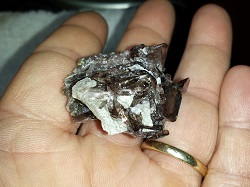A- |
B- |
C- |
D- |
E- |
F- |
G- |
H- |
I- |
J- |
K- |
L- |
M- |
N- |
O- |
P- |
Q- |
R- |
S- |
T- |
U- |
V- |
W- |
X- |
Y- |
Z |
AXINITE:Axinite is an interesting mineral and produces unique flattened spatula shaped crystals that fanciers of well formed crystals love to collect. It is a triclinic mineral which means that it has no symmetry planes or axes of rotation. It does possess a center of symmetry. A center of symmetry, or center, is a symmetry operation that takes a face on one side of a crystal and inverts in through the center of the crystal to the other side. The faces that are inverted are completely flipped both left to right and up to down. With this being the only symmetry operation, faces on axinite crystals are seemingly scattered everywhere and anywhere (except for their inverted partners on the other side of the crystal).Axinite is actually a series name for a group of isostructural minerals. All have the same structure but are different in terms of chemistry. They are named for their respective enrichment in either iron, magnesium and manganese, except for the iron manganese intermediate tinzenite. They differ slightly in color and specific gravity and most collectors refer to any of them as simply axinite, that is why they are treated as a single mineral here. Below is a list of the members of the axinite series and some of their properties: Ferro-axinite, iron rich, lilac brown to black, SG=3.31 Magnesio-axinite, magnesium rich, pale blue to gray, SG=3.18 Manganaxinite, manganese rich, yellow-orange, SG=3.32 Tinzenite, iron & manganese intermediate, yellow, SG=3.37 Manganaxinite is found at Franklin, New Jersey and is special due to a red fluorescence that is not seen in the other axinites and an attractive yellow-orange color. All axinites can have a one-of-a-kind color and crystal habit and a very nice luster that make them popular for collectors that like a different kind of crystal shape. PHYSICAL CHARACTERISTICS:Color is commonly a lilac brown but also yellow, yellow-orange, gray, pale blue and even black.Luster is vitreous. Transparency crystals are transparent to translucent. Crystal System is triclinic; bar 1. Crystal Habits include flattened wedge shaped crystals, often with a spatula or knife-like shaped edge. Also as granular and as parallel bladed aggregates. Cleavage is good in one direction. Fracture is conchoidal. Hardness is 6 - 7.5 Specific Gravity is approximately 3.0 - 3.4 (slightly above average for transparent minerals). Streak is white. Other Characteristics: crystals are heavily striated on some faces and manganese rich axinites have been known to be fluorescent red. Associated Minerals are diopside, andradite, quartz, calcite, epidote, scheelite and prehnite. Notable Occurrences include Madera Co., California and Franklin, New Jersey, USA; Baja California, Mexico; Bahia, Brazil; Switzerland; Obira, Japan; Cornwall, England and France. Best Field Indicators are crystal habit, hardness, color and striations. |

